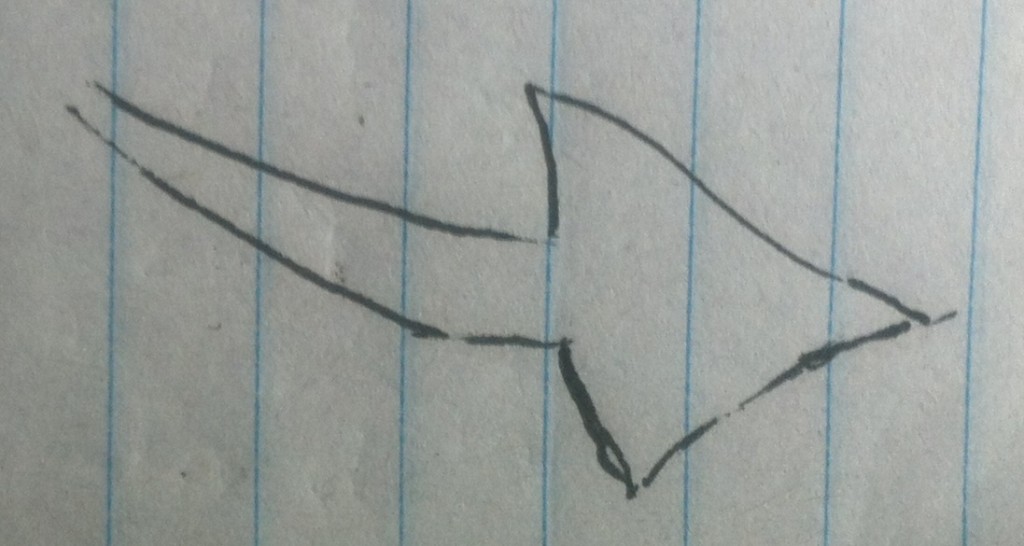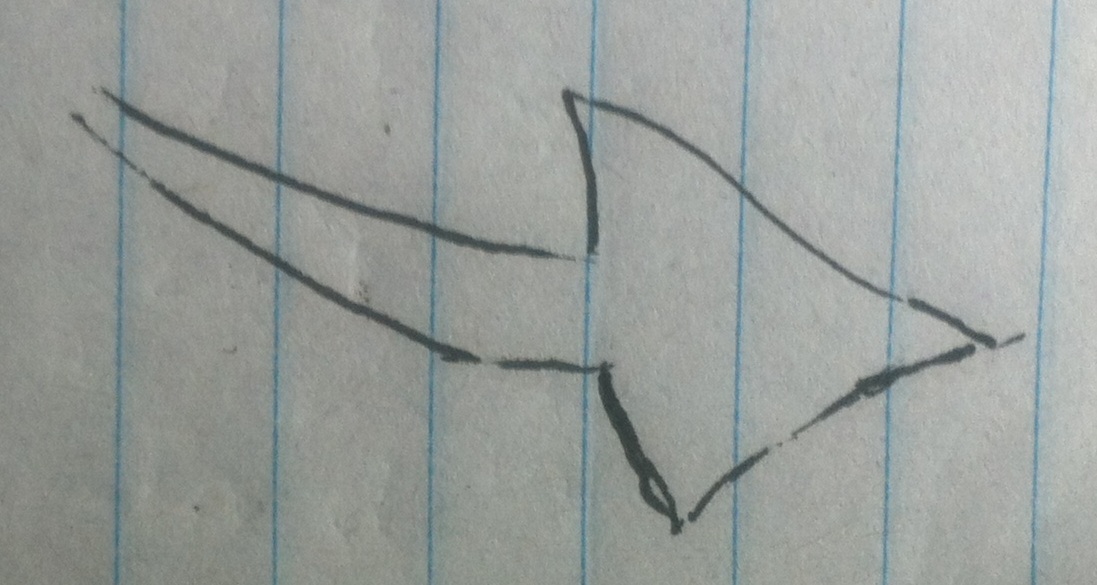I’ll reveal a few details about a new sighting report, since this blog is more for eyewitnesses rather than researchers; more details will probably be forthcoming in the next few days, but let’s take a sneak preview of this encounter. It includes a reference to what I have long presented as evidence for a Rhamphorhynchoid tail in featherless flying creatures that are observed worldwide: a structure at the end of a long tail, sometimes called a “diamond.”
.

Sketch by the eyewitness of the flying creature seen in Lakewood, CA, in mid-2012
.
Another Pterosaur Sighting in Lakewood, California
The following is subject to corrections, in case I have misunderstood initial remarks by the anonymous eyewitness.
I was sitting in the backyard facing East at about 11 pm. Looking up over the riverbed [a storm channel in Lakewood, California] . . . I saw what I took as a large bird with a wing span of around 4-6 feet that had an erratic gate to its flying. I watched it fly from North to South . . .
She then saw what looked like a prey animal that was being carried by the flying creature.
This isn’t a regular sight in Lakewood and I looked on with interest [and noticed] what looked like a long tail with a barbed object at the end . . . My first impression was that maybe it was the [prey] animal [that had a long tail]. . . . but the animal in its talons [the talons of the large flying creature, the captor] was clearly not attached to the tail that protruded from its captor. . . . descriptions of a dragon [went through my mind]. . . . the tail and the way it flew [appeared] like it was too heavy. I dismissed the whole thing thinking my eyes were playing tricks on me with the silhouette of the flying animal.
I am continuing to question this eyewitness. I believe that she saw a ropen and that it was having difficulty carrying the large prey animal. I was impressed that the prey was large enough that the eyewitness at first thought the long tail was from the prey rather than from the predator. If the eyewitness is patient enough, I will get around to asking her how large the prey was, compared with the predator.
Long Tail with “Triangle” at the end
The three “dragons” observed flying over a freeway near Griffith Park (Los Angeles, CA), in March of 2013 is an example. The eyewitness said, “their tails had triangular points.” Another eyewitness, in 1989 in Orange County, said that the “pterosaur” he saw had a long tail and “the end of its tail was triangular.” Other eyewitnesses use similar words for that tail-end structure. Take the mid-2007 sighting near California State University at Irvine (Orange County, CA). The tail was estimated at 15-16 feet long and the eyewitness said that a “triangle-shaped” structure was near the end of that tail. Sketch of the end of the tail, drawn by the eyewitness in Lakewood
.
Critic of Reports of Modern Pterosaurs With Long Tails One critic has made some strange suggestions about misidentifications. One comment he made was that a bird had a tail feather fluffed up, causing the end of the tail to look like the end of the tail of a Rhamphorhynchoid pterosaur. We have some strong refutations to that careless conjecture. Bulges at the end of long tails, on featherless flying creatures—those have been reported often and from around the world. In addition, many of those reports include other descriptions that pull the flying creatures out of any reasonable misidentification of any bird. For example, the ropen seen flying over Lake Pung, Umboi Island, Papua New Guinea, around early 1994 or late 1993, had a “diamond” at the end of the tail. This was not some blunder by seven native boys, some misidentification of some bird, for the tail was estimated at seven meters long, well over twenty feet. And why would eyewitnesses from around the world send me emails, many of the reports including reference to some structure at the end of a long tail? No. Let’s be realistic. When people from around the world report Rhamphorhynchoid pterosaur tail flanges, the existence of a living “basal” pterosaur must be considered, regardless of how long Westerner scientists have depended on the universal-extinction axiom for those flying creatures.
###
.
Remember your worst nightmare? Were you glad to wake up? Be grateful. In the early morning hours of February 23, 2010, a few miles or so southwest of Marfa, Texas, the victims were terrified by what awakened them. I am not the eyewitness, but a few days after this event, I interviewed my friend James, who had been driving through Southern Texas; he had stopped at the Marfa Lights viewing platform to see whatever he could.
. Jonathan Whitcomb, pterosaur expert
I agree, at least somewhat, with the critics’ idea that I am not a pterosaur fossil expert; compared with a typical paleontologist (I am neither typical anything nor a paleontologist), I am not an expert on fossils. . . . [but] . . .
.



